苏州大学医学部药学院:大类基础课程《生物化学 Biochemistry V》课程教学资源(电子教案)
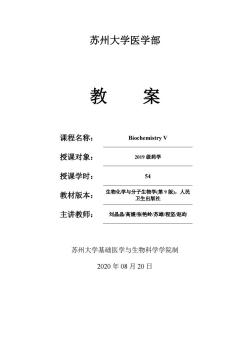
苏州大学医学部 教 案 课程名称: Biochemistry V 授课对象: 2019级药学 授课学时: 54 教材版本: 生物化学与分子生物学(第9版),人民 卫生出版社 主讲教师: 刘晶晶高媛/张艳岭/苏雄/程坚/赵昀 苏州大学基础医学与生物科学学院制 2020年08月20日
苏州大学医学部 教 案 课程名称: Biochemistry V 授课对象: 2019 级药学 授课学时: 54 教材版本: 生物化学与分子生物学(第 9 版),人民 卫生出版社 主讲教师: 刘晶晶/高媛/张艳岭/苏雄/程坚/赵昀 苏州大学基础医学与生物科学学院制 2020 年 08 月 20 日

Teaching plan of Soochow University Subjects:BIOCHEMISTRY Class:2019 Pharmaceutical Sciences Date:2020.9.9/Wed/5-6 Teaching duration:100 Chapter Text page:2-29 min Title Physical-Chemical Foundations of Biochemistry Teaching Foundations of Biochemistry goal Teaching content、 1.Biological Foundations 50 min 1.1 Classification System of Life 15 Teaching 1.2 Molecular Evolution 20 method、 1.3 Prokaryotes and Eukaryotes 15 Teaching 2.Chemical Foundations 50 min emphasis、 2.1 Elements in Life 5min difficulty、 2.2 Conformation vs Configuration 25min 2.3 Thermodynamics of Life 20min time distribution Teaching Multimedia teaching combine with PPT and viedo instrument Question 1. Chemistry Jargons in Biochemistry and quiz in class After class Prokaryotes and Eukaryotes summary Conformation and Configuration
Teaching plan of Soochow University Subjects:BIOCHEMISTRY Class:2019 Pharmaceutical Sciences Date:2020. 9. 9/Wed/5-6 Chapter 1 Text page:2-29 Teaching duration:100 min Title Physical-Chemical Foundations of Biochemistry Teaching goal Foundations of Biochemistry Teaching content、 Teaching method、 Teaching emphasis、 difficulty、 time distribution 1.Biological Foundations 50 min 1.1 Classification System of Life 15 1.2 Molecular Evolution 20 1.3 Prokaryotes and Eukaryotes 15 2.Chemical Foundations 50 min 2.1 Elements in Life 5min 2.2 Conformation vs Configuration 25min 2.3 Thermodynamics of Life 20min Teaching instrument Multimedia teaching combine with PPT and viedo Question and quiz in class 1. Chemistry Jargons in Biochemistry After class summary • Prokaryotes and Eukaryotes • Conformation and Configuration
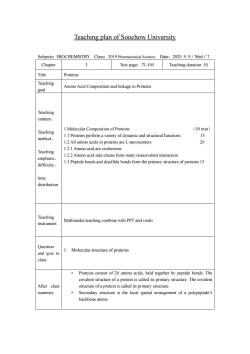
Teaching plan of Soochow University Subjects:BIOCHEMISTRY Class:2019 Pharmaceutical Sciences Date:2020.9.9/Wed/7 Chapter 3 Text page:71-100 Teaching duration:50 Title Proteins Teaching Amino Acid Composition and linkage in Proteins goal Teaching content、 1.Molecular Composition of Proteins (50 min) Teaching 1.1 Proteins perform a variety of dynamic and structural functions 15 nethod、 1.2 All amino acids in proteins are L steroisomers 20 Teaching 1.2.1 Amino acid are zwitterions emphasis、 1.2.2 Amino acid side chains form many noncovalent interaction difficulty、 1.3 Peptide bonds and disulfide bonds form the primary structure of proteins 15 time distribution Teaching Multimedia teaching combine with PPT and viedo instrument Question 1.Molecular structure of proteins and quiz in class Proteins consist of 20 amino acids,held together by peptide bonds.The covalent structure of a protein is called its primary structure.The covalent After class structure of a protein is called its primary structure. summary 。 Secondary structure is the local spatial arrangement of a polypeptide's backbone atoms
Teaching plan of Soochow University Subjects:BIOCHEMISTRY Class:2019 Pharmaceutical Sciences Date:2020. 9. 9/Wed/7 Chapter 3 Text page:71-100 Teaching duration: 50 Title Proteins Teaching goal Amino Acid Composition and linkage in Proteins Teaching content、 Teaching method、 Teaching emphasis、 difficulty、 time distribution 1.Molecular Composition of Proteins (50 min) 1.1 Proteins perform a variety of dynamic and structural functions 15 1.2 All amino acids in proteins are L steroisomers 20 1.2.1 Amino acid are zwitterions 1.2.2 Amino acid side chains form many noncovalent interaction 1.3 Peptide bonds and disulfide bonds form the primary structure of proteins 15 Teaching instrument Multimedia teaching combine with PPT and viedo Question and quiz in class 1. Molecular structure of proteins After class summary • Proteins consist of 20 amino acids, held together by peptide bonds. The covalent structure of a protein is called its primary structure. The covalent structure of a protein is called its primary structure. • Secondary structure is the local spatial arrangement of a polypeptide’s backbone atoms
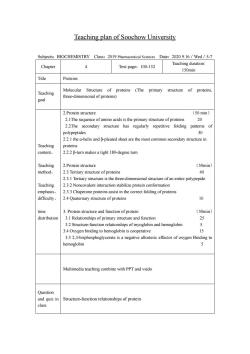
Teaching plan of Soochow University Subjects:BIOCHEMISTRY Class:2019 Pharmaceutical Sciences Date:2020.9.16/Wed/5-7 Teaching duration: Chapter 4 Text page:100-152 150min Title Proteins Molecular Structure of proteins (The Teaching primary structure of proteins. three-dimensional of proteins) goal 2.Protein structure (50 min) 2.IThe sequence of amino acids is the primary structure of proteins 20 2.2The secondary structure has regularly repetitive folding patterns of polypeptides 30 2.2.1 the a-helix and B-pleated sheet are the most common secondary structure in Teaching proteins content、 2.2.2 B-turn makes a tight 180-degree turn Teaching 2.Protein structure (50min) nethod、 2.3 Tertiary structure of proteins 40 2.3.1 Tertiary structure is the three-dimensional structure of an entire polypepide Teaching 2.3.2 Noncovalent interaction stabilize protein conformation emphasis、 2.3.3 Chaperone proteins assist in the correct folding of proteins difficulty、 2.4 Quaternary structure of proteins 10 time 3.Protein structure and function of protein (50min) distribution 3.1 Relationships of primary structure and function 25 3.2 Structure-function relationships of myoglobin and hemoglobin 5 3.4 Oxygen binding to hemoglobin is cooperative 15 3.5 2,3-bisphosphoglycerate is a negative allosteric effector of oxygen Binding to hemoglobin Multimedia teaching combine with PPT and viedo Question and quiz in Structure-function relationships of protein class
Teaching plan of Soochow University Subjects:BIOCHEMISTRY Class:2019 Pharmaceutical Sciences Date:2020.9.16/Wed/5-7 Chapter 4 Text page:100-152 Teaching duration: 150min Title Proteins Teaching goal Molecular Structure of proteins (The primary structure of proteins, three-dimensional of proteins) Teaching content、 Teaching method、 Teaching emphasis、 difficulty、 time distribution 2.Protein structure (50 min) 2.1The sequence of amino acids is the primary structure of proteins 20 2.2The secondary structure has regularly repetitive folding patterns of polypeptides 30 2.2.1 the α-helix and β-pleated sheet are the most common secondary structure in proteins 2.2.2 β-turn makes a tight 180-degree turn 2.Protein structure (50min) 2.3 Tertiary structure of proteins 40 2.3.1 Tertiary structure is the three-dimensional structure of an entire polypepide 2.3.2 Noncovalent interaction stabilize protein conformation 2.3.3 Chaperone proteins assist in the correct folding of proteins 2.4 Quaternary structure of proteins 10 3. Protein structure and function of protein (50min) 3.1 Relationships of primary structure and function 25 3.2 Structure-function relationships of myoglobin and hemoglobin 5 3.4 Oxygen binding to hemoglobin is cooperative 15 3.5 2,3-bisphosphoglycerate is a negative allosteric effector of oxygen Binding to hemoglobin 5 Multimedia teaching combine with PPT and viedo Question and quiz in class Structure-function relationships of protein
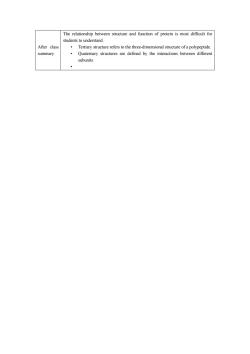
The relationship between structure and function of protein is most difficult for students to understand. After class Tertiary structure refers to the three-dimensional structure of a polypeptide summary Quaternary structures are defined by the interactions between different subunits
After class summary The relationship between structure and function of protein is most difficult for students to understand. • Tertiary structure refers to the three-dimensional structure of a polypeptide. • Quaternary structures are defined by the interactions between different subunits. •
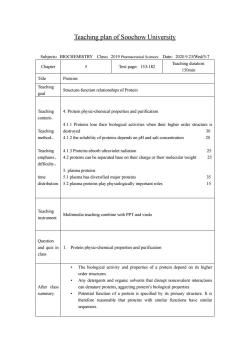
Teaching plan of Soochow University Subjects:BIOCHEMISTRY Class:2019 Pharmaceutical Sciences Date:2020.9.23/Wed/5-7 Teaching duration: Chapter 5 Text page:153-182 150min Title Proteins Teaching Structure-function relationships of Protein goal Teaching 4.Protein physic-chemical properties and purification content、 4.1.1 Proteins lose their biological activities when their higher order structure is Teaching destroyed 30 method、 4.1.2 the solubility of proteins depends on pH and salt concentration 20 Teaching 4.1.3 Proteins absorb ultraviolet radiation 25 emphasis、 4.2 proteins can be separated base on their charge or their molecular weight 25 difficulty、 5.plasma proteins time 5.1 plasma has diversified major proteins 35 distribution 5.2 plasma proteins play physiologically important roles 15 Teaching Multimedia teaching combine with PPT and viedo instrument Question and quiz in 1.Protein physic-chemical properties and purification class The biological activity and properties of a protein depend on its higher order structures. Any detergents and organic solvents that disrupt noncovalent interactions After class can denature proteins,aggecting protein's biological properties. summary Potential function of a protein is specified by its primary structure.It is therefore reasonable that proteins with similar functions have similar sequences
Teaching plan of Soochow University Subjects:BIOCHEMISTRY Class:2019 Pharmaceutical Sciences Date:2020.9.23/Wed/5-7 Chapter 5 Text page:153-182 Teaching duration: 150min Title Proteins Teaching goal Structure-function relationships of Protein Teaching content、 Teaching method、 Teaching emphasis、 difficulty、 time distribution 4. Protein physic-chemical properties and purification 4.1.1 Proteins lose their biological activities when their higher order structure is destroyed 30 4.1.2 the solubility of proteins depends on pH and salt concentration 20 4.1.3 Proteins absorb ultraviolet radiation 25 4.2 proteins can be separated base on their charge or their molecular weight 25 5. plasma proteins 5.1 plasma has diversified major proteins 35 5.2 plasma proteins play physiologically important roles 15 Teaching instrument Multimedia teaching combine with PPT and viedo Question and quiz in class 1. Protein physic-chemical properties and purification After class summary • The biological activity and properties of a protein depend on its higher order structures. • Any detergents and organic solvents that disrupt noncovalent interactions can denature proteins, aggecting protein’s biological properties. • Potential function of a protein is specified by its primary structure. It is therefore reasonable that proteins with similar functions have similar sequences

Teaching plan of Soochow University Subjects:BIOCHEMISTRY Class:2019 Pharmaceutical Sciences Date:2020/9/27/Sun/5-7 chapter 8 Text page:271-302 Teaching duration:150 Title Nucleic Acids 1.To understand the kinds and structure of nucleic acid Teaching 2.To understand the double helix and superhelix structure of nucleic acids goal Teaching content and time distribution Teaching Section 1 Nucleotides and polynucleotides 50min content、 1.1 Nucleotide is composed of base,pentose,and phosphoryl group 20min 1.2 Nucleotides have different derivatives 10min Teaching 1.3 Polynucleotide is formed when many nucleotides are linked together 10min method、 1.4 The primary structure of polynucleotides is the nucleotide sequence 10min Teaching Section 2 Structure and function of DNA 100min emphasis、 2.1 DNA is a double helix 50min difficulty、 2.2 The native DNA is supercoiled and has a highly organized structure 50min time Teaching method:teaching of teacher and discussion of students distribution Teaching emphasis and difficulty:the double helix of DNA;different forms of DNA;supercoile and highly organized structure of DNA Teaching Multimedia teaching combine with PPT and viedo instrument Question 1. What's the primary and secondary structure of DNA and quiz in 2. The different forms of DNA class After class Secondary structure of DNA is difficult for students to study. summary
Teaching plan of Soochow University Subjects:BIOCHEMISTRY Class:2019 Pharmaceutical Sciences Date:2020/9/27/Sun/5-7 chapter 8 Text page: 271-302 Teaching duration: 150 Title Nucleic Acids Teaching goal 1. To understand the kinds and structure of nucleic acid 2.To understand the double helix and superhelix structure of nucleic acids Teaching content、 Teaching method、 Teaching emphasis、 difficulty、 time distribution Teaching content and time distribution Section 1 Nucleotides and polynucleotides 50min 1.1 Nucleotide is composed of base, pentose, and phosphoryl group 20min 1.2 Nucleotides have different derivatives 10min 1.3 Polynucleotide is formed when many nucleotides are linked together 10min 1.4 The primary structure of polynucleotides is the nucleotide sequence 10min Section 2 Structure and function of DNA 100min 2.1 DNA is a double helix 50min 2.2 The native DNA is supercoiled and has a highly organized structure 50min Teaching method: teaching of teacher and discussion of students Teaching emphasis and difficulty: the double helix of DNA; different forms of DNA; supercoile and highly organized structure of DNA Teaching instrument Multimedia teaching combine with PPT and viedo Question and quiz in class 1. What’s the primary and secondary structure of DNA 2. The different forms of DNA After class summary Secondary structure of DNA is difficult for students to study
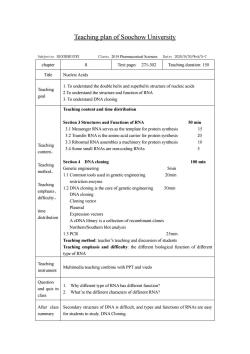
Teaching plan of Soochow University Subjects:BIOCHEMISTRY Class:2019 Pharmaceutical Sciences Date:2020/9/30/Wed/5-7 chapter 8 Text page:271-302 Teaching duration:150 Title Nucleic Acids 1.To understand the double helix and superhelix structure of nucleic acids Teaching 2.To understand the structure and function of RNA goal 3.To understand DNA cloning Teaching content and time distribution Section 3 Structures and Functions of RNA 50min 3.1 Messenger RNA serves as the template for protein synthesis 15 3.2 Transfer RNA is the amino acid carrier for protein synthesis 20 3.3 Ribosmal RNA assembles a machinery for protein synthesis 10 Teaching 3.4 Some small RNAs are non-coding RNAs 5 content、 Section 4 DNA cloning 100 min Teaching Genetic engineering 5min method、 1.1 Common tools used in genetic engineering 20min restriction enzyme Teaching 1.2 DNA cloning is the core of genetic engineering 50min emphasis、 DNA cloning difficulty、 Cloning vector Plasmid time Expression vectors distribution A cDNA library is a collection of recombinant clones Northern/Southern blot analysis 1.3 PCR 25min Teaching method:teacher's teaching and discussion of students Teaching emphasis and difficulty:the different biological function of different type of RNA Teaching Multimedia teaching combine with PPT and viedo instrument Question 1. Why different type of RNA has different function? and quiz in What're the different characters of different RNA? class After class Secondary structure of DNA is difficult,and types and functions of RNAs are easy summary for students to study.DNA Cloning
Teaching plan of Soochow University Subjects:BIOCHEMISTRY Class:2019 Pharmaceutical Sciences Date:2020/9/30/Wed/5-7 chapter 8 Text page: 271-302 Teaching duration: 150 Title Nucleic Acids Teaching goal 1. To understand the double helix and superhelix structure of nucleic acids 2.To understand the structure and function of RNA 3. To understand DNA cloning Teaching content、 Teaching method、 Teaching emphasis、 difficulty、 time distribution Teaching content and time distribution Section 3 Structures and Functions of RNA 50 min 3.1 Messenger RNA serves as the template for protein synthesis 15 3.2 Transfer RNA is the amino acid carrier for protein synthesis 20 3.3 Ribosmal RNA assembles a machinery for protein synthesis 10 3.4 Some small RNAs are non-coding RNAs 5 Section 4 DNA cloning 100 min Genetic engineering 5min 1.1 Common tools used in genetic engineering 20min restriction enzyme 1.2 DNA cloning is the core of genetic engineering 50min DNA cloning Cloning vector Plasmid Expression vectors A cDNA library is a collection of recombinant clones Northern/Southern blot analysis 1.3 PCR 25min Teaching method: teacher’s teaching and discussion of students Teaching emphasis and difficulty: the different biological function of different type of RNA Teaching instrument Multimedia teaching combine with PPT and viedo Question and quiz in class 1. Why different type of RNA has different function? 2. What’re the different characters of different RNA? After class summary Secondary structure of DNA is difficult, and types and functions of RNAs are easy for students to study. DNA Cloning
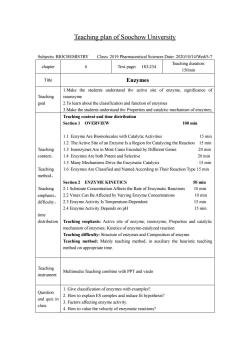
Teaching plan of Soochow University Subjects:BIOCHEMISTRY Class:2019 Pharmaceutical Sciences Date:2020/10/14/Wed/5-7 Teaching duration: chapter 6 Text page:183-234 150min Title Enzymes 1.Make the students understand the active site of enzyme,significance of Teaching isoenzyme goal 2.To learn about the classification and function of enzymes 3.Make the students understand the Properties and catalytic mechanism of enzymes; Teaching content and time distribution Section 1 OVERVIEW 100 min 1.1 Enzyme Are Biomolecules with Catalytic Activities 15 min 1.2 The Active Site of an Enzyme Is a Region for Catalyzing the Reaction 15 min Teaching 1.3 Isoenzymes Are in Most Cases Encoded by Different Genes 20 min content、 1.4 Enzymes Are both Potent and Selective 20 min 1.5 Many Mechanisms Drive the Enzymatic Catalysis 15 min Teaching 1.6 Enzymes Are Classified and Named According to Their Reaction Type 15 min method、 Section 2 ENZYME KINETICS 50 min Teaching 2.1 Substrate Concentration Affects the Rate of Enzymatic Reactions 10 min emphasis、 2.2 Vmax Can Be Affected by Varying Enzyme Concentrations 10 min difficulty、 2.3 Enzyme Activity Is Temperature-Dependent 15 min 2.4 Enzyme Activity Depends on pH 15 min time distribution Teaching emphasis:Active site of enzyme;isoenzyme;Properties and catalytic mechanism of enzymes;Kinetics of enzyme-catalyzed reaction Teaching difficulty:Structure of enzymes and Composition of enzyme. Teaching method:Mainly teaching method,in auxiliary the heuristic teaching method on appropriate time. Teaching Multimedia Teaching combine with PPT and viedo instrument 1.Give classification of enzymes with examples? Question 2.How to explain ES complex and induce fit hypothesis? and quiz in 3.Factors affecting enzyme activity. class 4.How to value the velocity of enzymatic reactions?
Teaching plan of Soochow University Subjects:BIOCHEMISTRY Class:2019 Pharmaceutical Sciences Date:2020/10/14/Wed/5-7 chapter 6 Text page: 183-234 Teaching duration: 150min Title Enzymes Teaching goal 1.Make the students understand the active site of enzyme, significance of isoenzyme 2.To learn about the classification and function of enzymes 3.Make the students understand the Properties and catalytic mechanism of enzymes; Teaching content、 Teaching method、 Teaching emphasis、 difficulty、 time distribution Teaching content and time distribution Section 1 OVERVIEW 100 min 1.1 Enzyme Are Biomolecules with Catalytic Activities 15 min 1.2 The Active Site of an Enzyme Is a Region for Catalyzing the Reaction 15 min 1.3 Isoenzymes Are in Most Cases Encoded by Different Genes 20 min 1.4 Enzymes Are both Potent and Selective 20 min 1.5 Many Mechanisms Drive the Enzymatic Catalysis 15 min 1.6 Enzymes Are Classified and Named According to Their Reaction Type 15 min Section 2 ENZYME KINETICS 50 min 2.1 Substrate Concentration Affects the Rate of Enzymatic Reactions 10 min 2.2 Vmax Can Be Affected by Varying Enzyme Concentrations 10 min 2.3 Enzyme Activity Is Temperature-Dependent 15 min 2.4 Enzyme Activity Depends on pH 15 min Teaching emphasis: Active site of enzyme; isoenzyme; Properties and catalytic mechanism of enzymes; Kinetics of enzyme-catalyzed reaction Teaching difficulty: Structure of enzymes and Composition of enzyme. Teaching method: Mainly teaching method, in auxiliary the heuristic teaching method on appropriate time. Teaching instrument Multimedia Teaching combine with PPT and viedo Question and quiz in class 1. Give classification of enzymes with examples? 2. How to explain ES complex and induce fit hypothesis? 3. Factors affecting enzyme activity. 4. How to value the velocity of enzymatic reactions?

After class The relationship between structure and function of enzyme is most difficult for summary students to understand
After class summary The relationship between structure and function of enzyme is most difficult for students to understand
按次数下载不扣除下载券;
注册用户24小时内重复下载只扣除一次;
顺序:VIP每日次数-->可用次数-->下载券;
- 苏州大学医学部药学院:大类基础课程《生物化学 Biochemistry V》课程教学资源(教学大纲).pdf
- 苏州大学医学部药学院:大类基础课程《分子细胞生物学 Molecular cell Biology》课程教学资源(授课教案).pdf
- 苏州大学医学部药学院:大类基础课程《分子细胞生物学 Molecular cell Biology》课程教学资源(教学大纲).docx
- 苏州大学医学部药学院:大类基础课程《免疫学及微生物学 Microbiology & Immunology》课程教学资源(电子教案).docx
- 苏州大学医学部药学院:大类基础课程《免疫学及微生物学 Microbiology & Immunology》课程教学资源(教学大纲).pdf
- 苏州大学医学部药学院:大类基础课程《无机化学 Inorganic Chemistry》课程教学资源(电子教案).docx
- 苏州大学医学部药学院:大类基础课程《无机化学 Inorganic Chemistry》课程教学资源(教学大纲).docx
- 苏州大学医学部药学院:大类基础课程《分析化学 Analytical Chemistry》课程教学资源(电子教案).docx
- 苏州大学医学部药学院:大类基础课程《分析化学 Analytical Chemistry》课程教学资源(教学大纲).docx
- 苏州大学医学部药学院:大类基础课程《有机化学 Organic Chemistry》课程教学资源(电子教案).docx
- 苏州大学医学部药学院:大类基础课程《有机化学 Organic Chemistry》课程教学资源(教学大纲).docx
- 苏州大学医学部药学院:大类基础课程《物理化学 Physical Chemistry》课程教学资源(电子教案).docx
- 苏州大学医学部药学院:大类基础课程《物理化学 Physical Chemistry》课程教学资源(教学大纲).docx
- 苏州大学医学部药学院:大类基础课程《细胞与分子生物学实验 Cellular and Molecular Biology Experiment》课程教学资源(电子教案).pdf
- 苏州大学医学部药学院:大类基础课程《细胞与分子生物学实验 Cellular and Molecular Biology Experiment》课程教学资源(教学大纲).docx
- 苏州大学医学部药学院:大类基础课程《微生物与免疫学实验 Microbiology & Immunology Experiments》课程教学资源(电子教案).docx
- 苏州大学医学部药学院:大类基础课程《微生物与免疫学实验 Microbiology & Immunology Experiments》课程教学资源(教学大纲).docx
- 苏州大学医学部药学院:专业必修课程《学科综合训练 Comprehensive Discipline Training》课程教学资源(教学大纲).docx
- 苏州大学医学部药学院:专业必修课程《药物合成 Drug Synthesis》课程教学资源(电子教案).docx
- 苏州大学医学部药学院:专业必修课程《药物合成 Drug Synthesis》课程教学资源(教学大纲).docx
- 苏州大学医学部药学院:大类基础课程《生物化学实验 Biochemistry V Experiment》课程教学资源(电子教案).pdf
- 苏州大学医学部药学院:大类基础课程《生物化学实验 Biochemistry V Experiment》课程教学资源(教学大纲).pdf
- 苏州大学医学部药学院:大类基础课程《解剖生理学 Anatomical Physiology》课程教学资源(电子教案).pdf
- 苏州大学医学部药学院:大类基础课程《解剖生理学 Anatomical Physiology(人体解剖学 Human Anatomy part)》课程教学资源(教学大纲).docx
- 苏州大学医学部药学院:大类基础课程《解剖生理学实验 Anatomical Physiology Experiment》课程教学资源(教学大纲).docx
- 苏州大学医学部药学院:大类基础课程《解剖生理学实验 Anatomical Physiology Experiment》课程教学资源(电子教案).docx
- 苏州大学医学部药学院:大类基础课程《物理化学及实验 Physical chemistry and Experiments》课程教学资源(教学大纲).docx
- 山东大学:药剂学(PPT课件讲稿)Pharmaceutics.ppt
- 长沙医学院:《药剂学》课程教学资源(PPT课件讲稿)第八章 软膏剂与凝胶剂.ppt
- 长沙医学院:《药剂学》课程教学资源(PPT课件讲稿)第七章 注射剂和滴眼剂(7.5-7.7).ppt
- 长沙医学院:《药剂学》课程教学资源(PPT课件讲稿)第三章 散剂、颗粒剂与胶囊剂 第一节 粉体学简介(Micromeritics).ppt
- 长沙医学院:《药剂学》课程教学资源(PPT课件讲稿)第十五章 药物制剂的稳定性.ppt
- 长沙医学院:《药剂学》课程教学资源(PPT课件讲稿)第十章 中药药剂学——散剂.ppt
- 长沙医学院:《药剂学》课程教学资源(PPT课件讲稿)第四章 片剂(主讲:唐靖).ppt
- 西安交通大学第二附属医院:药学简讯(2017年第3期,总第76期).pdf
- 电子科技大学:《药学监护实践与方法 Pharmacological Monitoring Method and Practice》课程教学资源(课件讲稿)以患者为中心的药物治疗管理服务——前言、第1章 药物治疗管理服务概述 - 药师的主战场(闫峻峰、杜珊、刘心霞).pdf
- 电子科技大学:《药学监护实践与方法 Pharmacological Monitoring Method and Practice》课程教学资源(课件讲稿)第2章 药学监护是药物治疗管理服务的专业实践.pdf
- 电子科技大学:《药学监护实践与方法 Pharmacological Monitoring Method and Practice》课程教学资源(课件讲稿)第3章 药学监护实践的执业理念.pdf
- 电子科技大学:《药学监护实践与方法 Pharmacological Monitoring Method and Practice》课程教学资源(课件讲稿)第4章 以患者为中心的内涵.pdf
- 电子科技大学:《药学监护实践与方法 Pharmacological Monitoring Method and Practice》课程教学资源(课件讲稿)第5章 药物治疗问题.pdf
